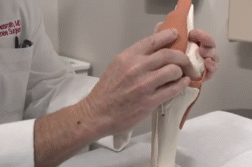LOUISVILLE, Ky. (Ivanhoe Newswire)— For the past decade, researchers have studied the impact of epidural stimulation, which is a small amount of electrical current applied to the spine, on people with spinal cord injury. The technology has gotten better over the past few years, and now some patients are achieving what most believed would never be possible. One man celebrates his personal victories over paralysis, one milestone at a time.
Jerod Nieder remembers the exact moment his life changed forever. December 18th, 2011. He was on vacation with his family in Mexico.
“It was the first day of the trip. I went running down the beach to dive into the ocean and dove right into a sandbar,” Nieder told Ivanhoe Newswire.
The damage to his spinal cord was done.
“The doctors told my family I would never feed myself and to just prepare for this to be the rest of my life,” Nieder said.
Jerod refused to accept that. He and his mom began searching for cutting-edge rehabilitation.
At the Kentucky Spinal Cord Injury Research Center, scientists use programmed electrical stimulation to help patients stand and control their core. Jerod is one of 38 patients with a stimulator inside his body.
“The electrode is a 16-electrode array. It contains 16 contacts, and it is implanted in what’s called the lumbar sacral spinal cord,” Claudia Angeli, PhD, director of the Epidural Stimulation Program at the University of Louisville, explained.
It was Jerod’s determination and positivity that caught Hanna Alcock’s eye.
“My friend told me that a guy named Jerod who was in a wheelchair, was very social, but never got out of his apartment, and just needed some help on Saturdays. I was like, well, I think I can do that,” Alcock said.
It didn’t take long before Saturdays became special, for both.
“I thought it turned into something else before Hanna realized it turned into something else,” Jerod joked.
Jerod proposed and Hanna said yes.
Hanna was also an inspiration for Jerod. He watched her compete in the New York City Marathon, so Jerod began to train for the 26.2-mile race.
On November 6th, Jerod took off. Despite crashing his hand cycle at mile 13, Jerod finished, with his bike stuck in first gear. The couple had one more milestone to reach. Hanna suggested they marry on the 10-year anniversary of Jerod’s accident.
“It’s a day that a lot got taken from me and to have Hanna come into my life and help me take charge of that is just, it means a lot to me,” Nieder said.
Jerod worked for months in the lab to surprise his family and friends.
“We’re having a traditional Korean part of the ceremony. That is where I’m supposed to bow to her parents,” he explained.
On December 18th, the man who doctors predicted would never use his arms or legs, bowed, all the way down, three times, with support from his lab assistants. He vows, he’s not done yet.
Jerod added, “The list of things that I’m able to do gets longer, and the things that I’m not able to do gets shorter.”
By running the NYC Marathon as part of Team Reeve, Jerod and Hanna have raised over $20,000 together for the Christopher and Dana Reeve Foundation. The Reeve Foundation funds the epidural stimulation trial at the University of Louisville Kentucky Spinal Cord Injury Research Center.
Contributors to this news report include: Cyndy McGrath, Producer; Kirk Manson, Videographer, Roque Correa, Editor.
To receive a free weekly e-mail on medical breakthroughs from Ivanhoe, sign up at: http://www.ivanhoe.com/ftk
Sources:
https://www.nscisc.uab.edu/Public/Facts%20and%20Figures%20-%202018.pdf
https://victoryoverparalysis.org/epidural-timeline/
https://www.who.int/news-room/fact-sheets/detail/spinal-cord-injury
https://www.christopherreeve.org/
https://www.christopherreeve.org/blog/research-news/hope-happens-here-the-big-idea
MEDICAL BREAKTHROUGHS
RESEARCH SUMMARY
TOPIC: SPINAL CORD STIMULATION: JEROD’S VICTORIES OVER PARALYSIS
REPORT: MB #5015
BACKGROUND: Every year, between 250,000 and 500,000 people suffer a spinal cord injury, according to the World Health Organization. Quadriplegia occurs when the neck area of the spinal cord is injured; the severity of the injury and the place it occurred can determine the amount of function a person will maintain. Since 2015, the causes of spinal cord injuries are 38.6% vehicular, 32.2% falls, 14% violence, 7.8% sports, and 4.2% medical or surgical. The average age at the time of a spinal cord injury is currently 43 and males account for 78% of new spinal cord injury cases.
(Sources: https://www.brainandspinalcord.org/quadriplegia/
https://www.who.int/news-room/fact-sheets/detail/spinal-cord-injury
https://www.themiamiproject.org/resources/statistics/)
BENEFITS OF SPINAL THERAPY: According to Dr. Susan Harkema, the Rehabilitation Research Director at the Kentucky Spinal Cord Injury Research Center, after a spinal cord injury, you lose movement, cardiovascular/respiratory, bowel, bladder, and sexual function. In 2018, the University of Louisville did research on epidural stimulation to help people with spinal cord injuries. Epidural stimulation is done using an electrode that lies in the lower part of the spinal cord, right where a specific network of nerves is located. “My life has changed with the epidural stimulator because we’ve been able to regulate my blood pressure,” says Stefanie Putnam, a participant in the research. “I went pretty immediately from passing out six times a day to not passing out.”
(Source: https://www.ket.org/living/kentucky-spinal-cord-injury-research-center/)
NEW TECHNOLOGY: Recently, the National Institute of Neurological Disorders and Stroke announced that they would fund $7.8 million to the University of Louisville Research Center in collaboration with Medtronic to focus on incorporating technology that would improve locomotor and bladder control using epidural stimulation. “Integrating multiple systems will allow people with chronic spinal cord injuries to benefit from stimulation on a daily basis by reducing the need to monitor and manually revise stimulation settings,” says Claudia Angeli, director of the Epidural Stimulation Program at the Kentucky Spinal Cord Injury Research Center. The goal of the new project is to develop integrated, close-loop programming for multiple systems using wireless sensors to monitor the user’s condition.
FOR MORE INFORMATION ON THIS REPORT, PLEASE CONTACT:
Betty Coffman
502-852-4573
If this story or any other Ivanhoe story has impacted your life or prompted you or someone you know to seek or change treatments, please let us know by contacting Marjorie Bekaert Thomas at mthomas@ivanhoe.com




